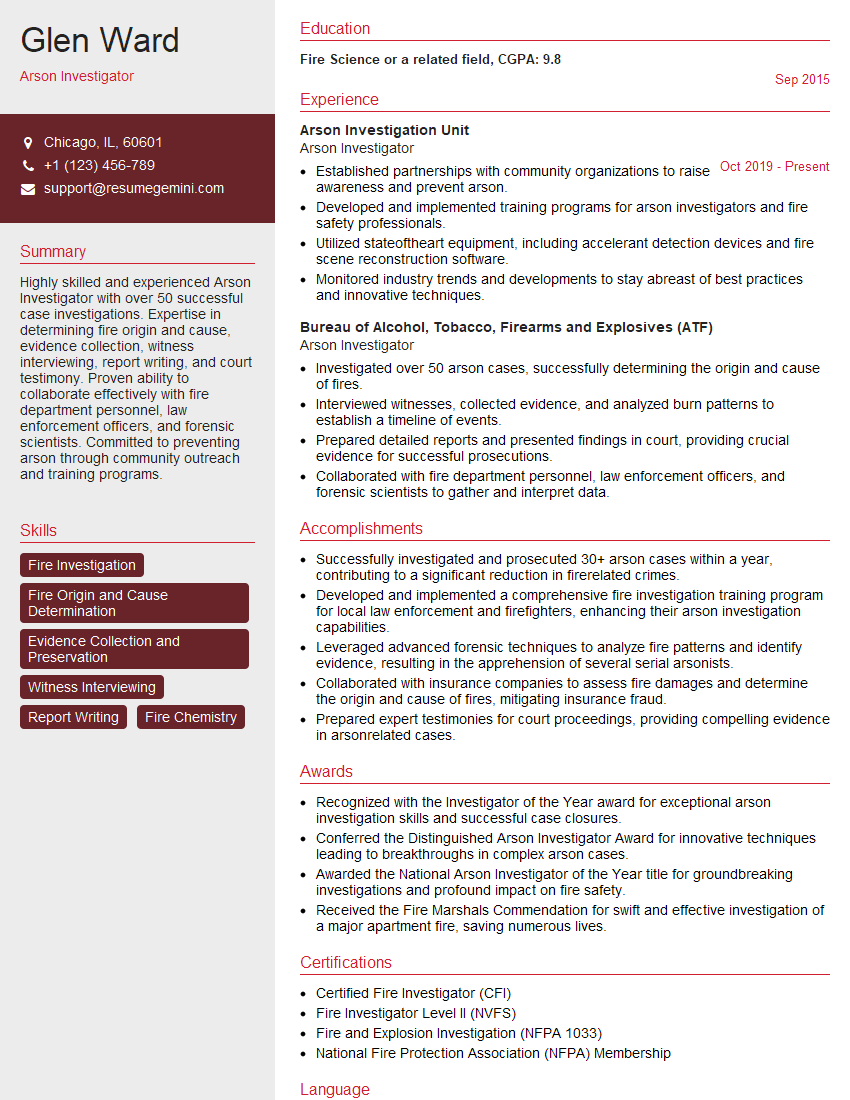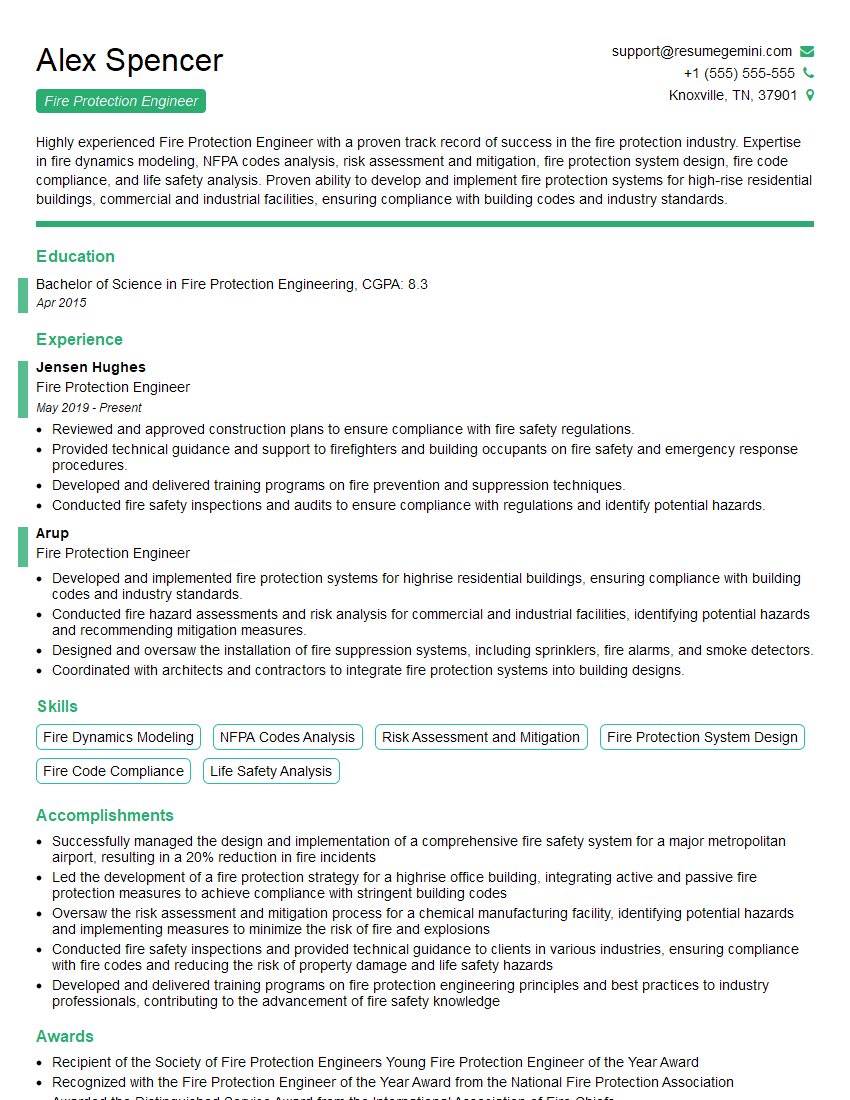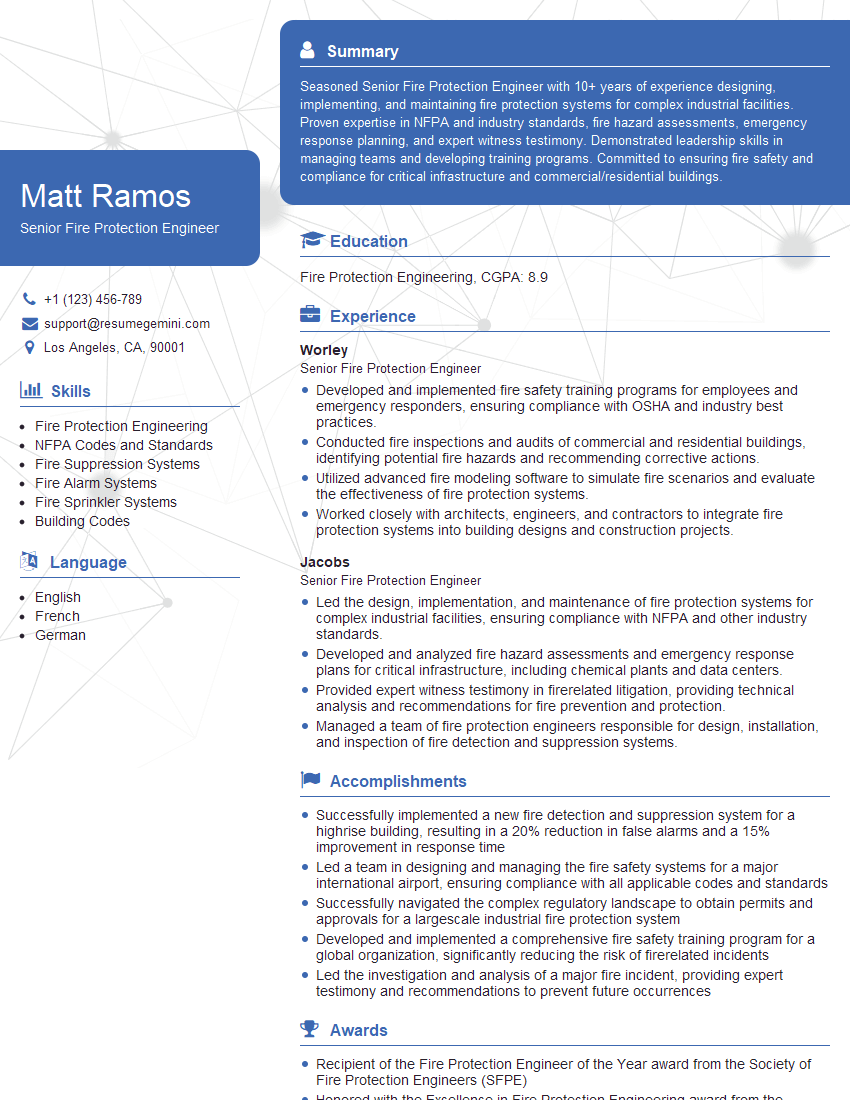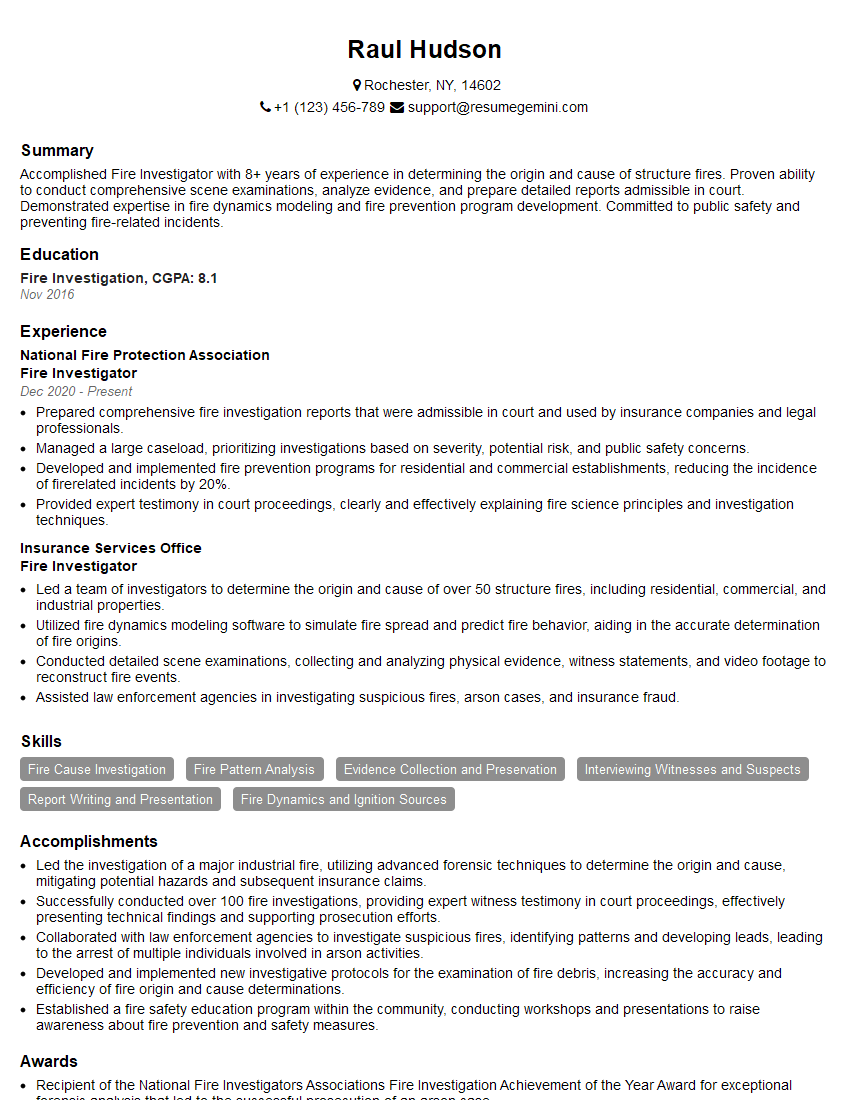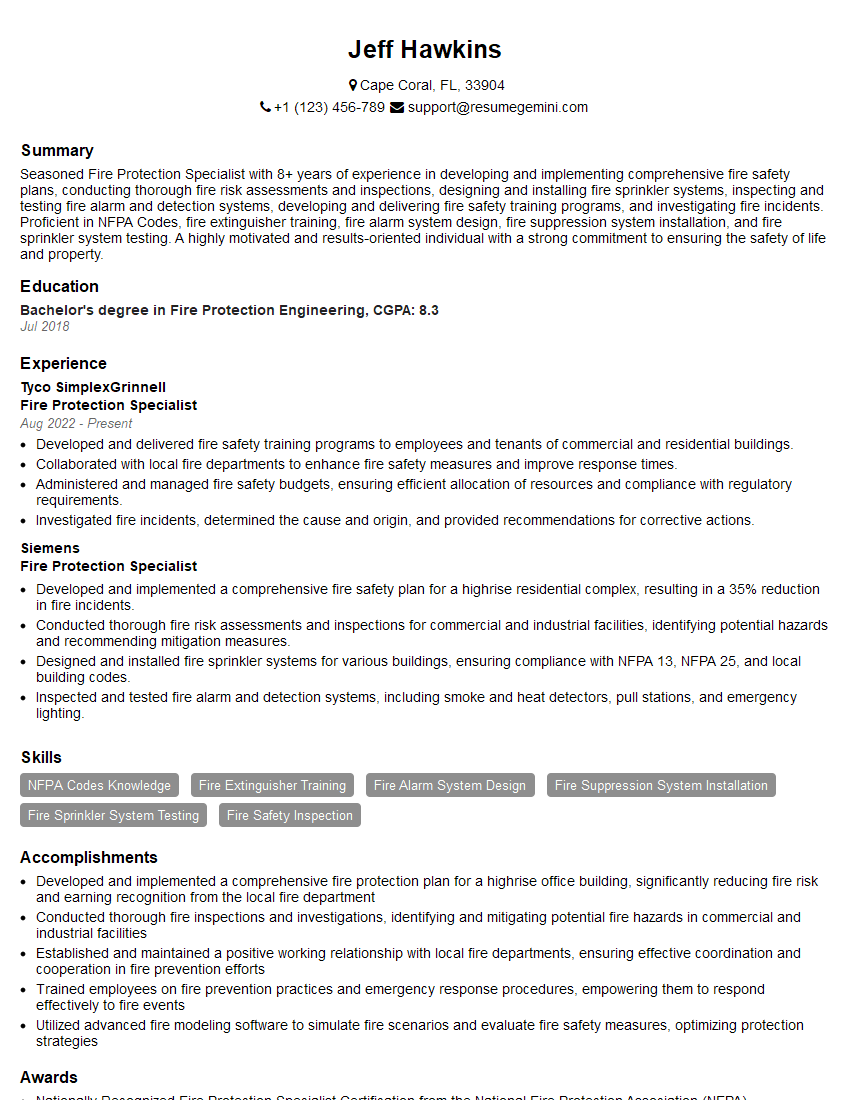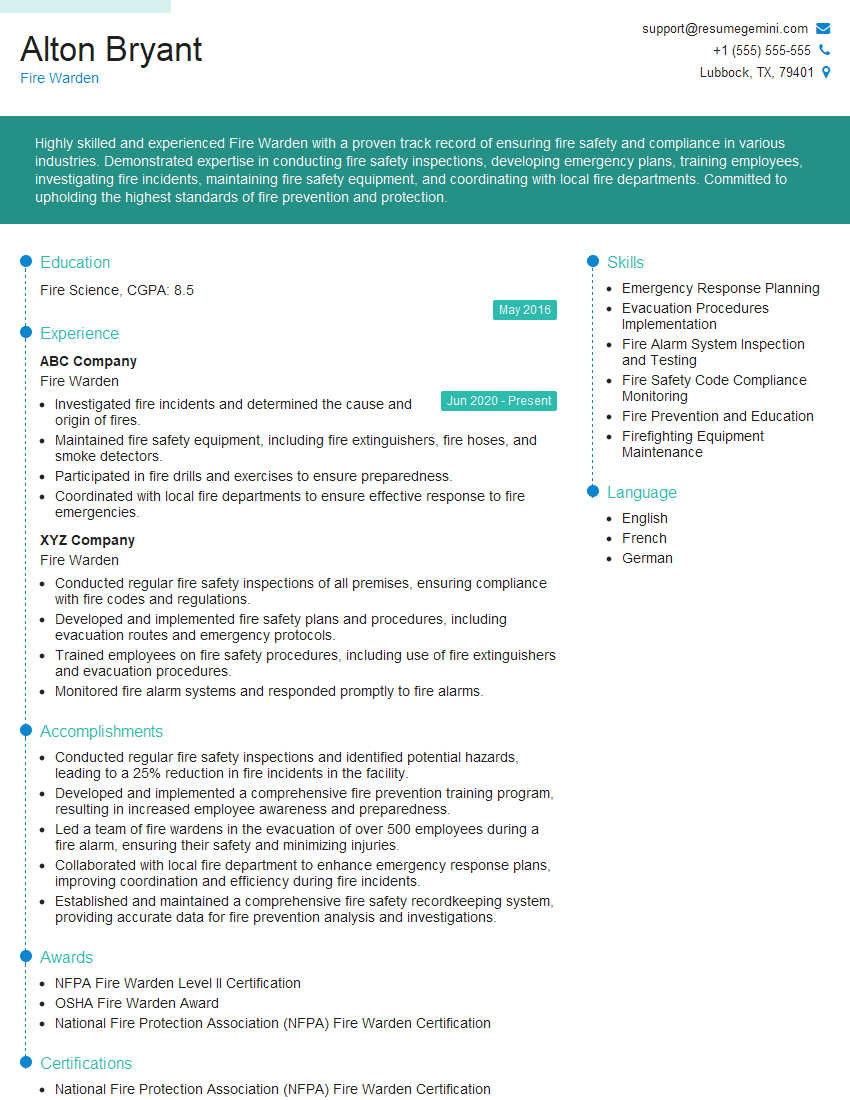Cracking a skill-specific interview, like one for Fire Performance, requires understanding the nuances of the role. In this blog, we present the questions you’re most likely to encounter, along with insights into how to answer them effectively. Let’s ensure you’re ready to make a strong impression.
Questions Asked in Fire Performance Interview
Q 1. Explain the different types of fire suppression systems.
Fire suppression systems are designed to control or extinguish fires. They vary widely depending on the type of fire hazard and the size and type of building. The most common types include:
- Water-based systems: These are the most prevalent, using water in various forms (e.g., sprinklers, hose reels, deluge systems) to cool the burning material and suppress the fire. Sprinklers, for instance, are activated by heat and release water directly onto the fire’s source. Deluge systems, on the other hand, release water over a larger area simultaneously.
- Foam systems: These systems use specialized foam agents to create a blanket that smothers the fire, cutting off its oxygen supply. They are particularly effective on flammable liquid fires.
- Gas suppression systems: These systems use inert gases like carbon dioxide (CO2), Argon, or Argonite to displace oxygen, suffocating the fire. They are ideal for areas containing sensitive electronic equipment or where water damage would be catastrophic.
- Dry chemical systems: These systems use dry chemical powders that disrupt the chemical chain reaction of the fire. Different powders are effective against different classes of fire.
- Wet chemical systems: These systems are specifically designed for kitchen fires involving cooking oils and fats. They release a special chemical that saponifies the grease, breaking down the burning fuel and inhibiting reignition.
The choice of fire suppression system depends on a thorough fire risk assessment considering factors such as the occupancy type, fire hazards present, and building construction.
Q 2. Describe your experience with fire risk assessments.
I have extensive experience conducting fire risk assessments across diverse environments, including commercial buildings, industrial facilities, and residential complexes. My approach is methodical and follows established standards. I begin by meticulously surveying the premises, identifying potential fire hazards (flammable materials, ignition sources, escape routes), and evaluating existing fire safety measures. I then analyze the potential consequences of a fire, including loss of life, property damage, and business interruption. This analysis informs the development of a comprehensive risk assessment report, which includes detailed recommendations for improvements to fire safety practices and the implementation of appropriate fire prevention and protection measures. For example, I recently conducted an assessment for a large warehouse facility, identifying deficiencies in their sprinkler system coverage and recommending upgrades based on the NFPA standards. My detailed report led to significant improvements in their overall fire safety profile.
Q 3. What are the key components of a fire safety plan?
A comprehensive fire safety plan is the cornerstone of fire protection. It outlines procedures to minimize the risk of fire and ensure the safety of occupants during a fire emergency. Key components include:
- Fire hazard identification and risk assessment: A detailed analysis of potential fire hazards within the facility.
- Emergency evacuation plan: Clear procedures for evacuation, including designated escape routes, assembly points, and communication protocols. This should also consider the needs of disabled individuals.
- Fire prevention measures: Strategies to prevent fires from starting, such as regular maintenance of electrical systems, proper storage of flammable materials, and employee training on fire safety.
- Fire detection and alarm system: Description of the fire alarm system, its components, and testing procedures. This might also cover smoke detectors, heat detectors and other related fire detection devices.
- Fire suppression system: Details of the fire suppression system (if any), including type, location, and maintenance schedule. This often includes details on how to use fire extinguishers.
- Emergency response plan: Procedures for responding to a fire, including reporting procedures, communication with emergency services, and the roles and responsibilities of designated personnel.
- Training and drills: Regular fire safety training for employees and occupants, including practice drills.
- Maintenance and inspection schedule: A clear schedule for regular inspection and maintenance of fire safety equipment and systems.
A well-developed fire safety plan is a living document; it should be regularly reviewed and updated to reflect changes in the facility or its operations.
Q 4. How do you determine the appropriate fire extinguisher for a specific hazard?
Selecting the right fire extinguisher is crucial for effective fire suppression. The choice depends on the class of fire, which is determined by the type of burning material:
- Class A: Ordinary combustibles (wood, paper, cloth). Use a water-based extinguisher.
- Class B: Flammable liquids (gasoline, oil, grease). Use a foam, CO2, or dry chemical extinguisher.
- Class C: Electrical fires. Use a CO2 or dry chemical extinguisher (never water!).
- Class D: Combustible metals (magnesium, titanium). Use a special dry powder extinguisher designed for this class of fire.
- Class K: Cooking oils and fats. Use a wet chemical extinguisher.
The size of the extinguisher should also be considered, selecting one appropriate for the size of the potential fire. Always check the extinguisher’s pressure gauge to ensure it’s fully charged and ready for use. For example, a small Class A extinguisher would be suitable for a small wastebasket fire, while a larger Class B extinguisher would be needed for a spill of flammable liquid.
Q 5. Explain the concept of compartmentalization in fire safety.
Compartmentalization is a critical fire safety strategy that involves dividing a building into smaller, self-contained compartments using fire-resistant barriers. These barriers, typically fire-rated walls, floors, and doors, restrict the spread of fire and smoke, allowing more time for evacuation and fire suppression. Think of it as creating firebreaks within a building. By limiting the area affected by a fire, compartmentalization prevents the rapid escalation of a small fire into a large-scale disaster, protecting both life and property. This also allows firefighters to more easily contain and extinguish the fire. For instance, in a multi-story building, fire-rated floors limit the vertical spread of fire, protecting the occupants of other floors.
Q 6. What are the common causes of building fires?
Building fires have many causes, but some common ones include:
- Electrical faults: Overloaded circuits, faulty wiring, and malfunctioning appliances are frequent culprits. Think of overloaded power strips or damaged cords.
- Smoking materials: Discarded cigarettes are a leading cause of residential fires.
- Cooking fires: Unattended cooking or grease fires in kitchens are a significant source of fires, particularly in restaurants and residential settings.
- Heating equipment: Faulty heaters, improperly installed chimneys, and space heaters too close to flammable materials are major risks.
- Arson: Deliberately set fires represent a significant threat.
- Flammable materials: Improper storage or handling of flammable liquids, gases, and solids can lead to fires.
- Lightning strikes: Though less frequent, lightning strikes can ignite flammable materials.
Prevention focuses on addressing these root causes through regular maintenance, proper installation, and responsible behavior.
Q 7. Describe your experience with fire investigation techniques.
My experience in fire investigation encompasses a systematic approach, starting with securing the scene to preserve evidence. I utilize a variety of techniques, including:
- Witness interviews: Gathering information from eyewitnesses about the events leading up to and during the fire.
- Scene examination: A meticulous examination of the fire scene to identify the origin and cause of the fire. This includes documenting burn patterns, examining damage, and collecting samples.
- Evidence collection and analysis: Collecting physical evidence, such as debris samples, electrical components, and accelerants, for laboratory analysis.
- Photographic and video documentation: Creating a comprehensive record of the fire scene to support the investigation.
- Fire modeling and simulation: Using computer modeling to recreate the fire’s progression and determine its cause.
I adhere to strict protocols to ensure the integrity of the investigation and the accuracy of the findings. A recent investigation involved a warehouse fire, where meticulous scene examination revealed an electrical fault as the ignition source, preventing similar incidents in the future by informing safety improvements.
Q 8. How familiar are you with NFPA codes and standards?
I possess extensive familiarity with NFPA codes and standards. My work regularly involves referencing and applying these codes, particularly NFPA 101 (Life Safety Code), NFPA 72 (National Fire Alarm Code), and NFPA 13 (Standard for the Installation of Sprinkler Systems). I understand the nuances of these codes, including their implications for building design, construction, and ongoing maintenance. For example, I’ve utilized NFPA 101 to evaluate the adequacy of egress paths in high-rise buildings and applied NFPA 13 to design sprinkler systems for industrial facilities, ensuring compliance with all relevant requirements and ensuring the safety of occupants.
I also stay updated on any revisions or amendments to these codes through continuous professional development. This allows me to offer clients the most current and effective fire safety solutions, reflecting best practices within the industry. Understanding these codes isn’t just about compliance; it’s about proactively minimizing fire risks and ensuring life safety.
Q 9. Explain the importance of fire drills and emergency evacuation procedures.
Fire drills and emergency evacuation procedures are crucial for several reasons. They’re not just about compliance; they’re about saving lives. Regular drills familiarize occupants with escape routes, assembly points, and emergency procedures, reducing panic and confusion during an actual fire. They also identify weaknesses in the existing plan, allowing for timely adjustments.
- Improved Response Time: Practice makes perfect. Drills shorten the time it takes to evacuate a building safely, maximizing survival chances.
- Identification of Hazards: Drills help identify obstacles or bottlenecks in escape routes, allowing for immediate remediation.
- Enhanced Teamwork: Drills promote teamwork and coordination amongst staff and occupants, crucial for efficient evacuation.
- Reduced Anxiety: Familiarization with procedures helps reduce anxiety in emergency situations.
For instance, during a recent project, a fire drill revealed a blocked fire exit in a large office complex. This was addressed immediately, averting a potentially disastrous situation.
Q 10. How do you conduct a fire safety inspection?
A thorough fire safety inspection involves a systematic assessment of the entire premises. My approach involves a multi-stage process:
- Pre-Inspection Planning: Reviewing building plans and documentation to understand the building’s layout and fire protection systems.
- Visual Inspection: A comprehensive walkthrough of the premises to identify any fire hazards, including blocked exits, damaged equipment, improper storage of flammable materials, and malfunctioning fire protection systems. This is where I’d look at things like the state of fire extinguishers, the functionality of smoke detectors, and the overall cleanliness of escape routes.
- Testing of Systems: Testing the functionality of fire alarm systems, sprinkler systems, and other fire protection equipment. This might involve activating alarm pull stations or checking sprinkler system water pressure. I always document all test results.
- Documentation and Reporting: Detailed documentation of all findings, including photographs and descriptions of hazards. This culminates in a comprehensive report with prioritized recommendations for remediation.
Consider, for example, inspecting a kitchen: I would check for proper grease trap maintenance, the condition of fire suppression systems specifically designed for kitchens (like Class K systems), and the correct storage of flammable materials. Every area has its unique fire safety considerations.
Q 11. What are the different classes of fire and how are they extinguished?
Fires are classified into different classes based on the type of fuel involved, each requiring a specific extinguishing agent:
- Class A: Ordinary combustibles (wood, paper, cloth). Extinguished with water, which cools the fuel and reduces its flammability.
- Class B: Flammable liquids (gasoline, oil, grease). Extinguished by interrupting the oxygen supply or by using a smothering agent like carbon dioxide (CO2) or dry chemical powder.
- Class C: Energized electrical equipment. Requires a non-conductive extinguishing agent like CO2 or dry chemical powder to avoid electrical shock.
- Class D: Combustible metals (magnesium, titanium). Requires specialized extinguishing agents like dry powder or metal-specific agents.
- Class K: Cooking oils and fats. Requires a special extinguishing agent designed to cool and saponify (form soap) with the burning oil.
It’s crucial to use the correct extinguishing agent for each class of fire. Using water on a Class B fire, for example, could spread the flames, while attempting to extinguish a Class C fire with water could lead to electrocution.
Q 12. Describe your experience with fire modeling software.
I have extensive experience using various fire modeling software packages, including FDS (Fire Dynamics Simulator) and CFAST (Consolidated Model of Fire and Smoke Transport). These tools allow me to simulate fire behavior in different scenarios, predicting smoke spread, temperature profiles, and the effectiveness of fire protection systems. This helps in designing optimal fire safety strategies and assessing the impact of different design choices.
For example, I used FDS to model the potential fire spread in a new hospital design, testing different sprinkler system layouts and evacuation strategies. The simulation helped us identify potential vulnerabilities and refine the design to minimize risk. The software provides valuable data-driven insights that go beyond simple guesswork.
Q 13. How do you evaluate the effectiveness of a fire suppression system?
Evaluating the effectiveness of a fire suppression system is a multi-faceted process. It involves:
- Regular Inspections: Visual inspections and functional testing to ensure components are in good working order.
- Water Pressure Tests (for sprinkler systems): Regularly checking water pressure to ensure adequate flow in the event of a fire.
- System Activation Tests (with appropriate permits and precautions): Controlled tests under simulated conditions to verify the system’s response and effectiveness.
- Post-Fire Analysis (in the event of a fire): A thorough examination of the system’s performance during the fire, identifying areas for improvement.
- Data Analysis from Fire Modeling Software: Using simulation software to evaluate the system’s likely effectiveness in various fire scenarios.
For instance, I recently evaluated a sprinkler system in a warehouse following a small fire. The post-fire analysis showed some sprinkler heads had failed to activate correctly; this helped in identifying the need for maintenance and system upgrades to prevent future failures.
Q 14. What are the key factors to consider when designing a fire alarm system?
Designing a fire alarm system requires considering several key factors:
- Building Occupancy and Use: Different building types have different alarm system requirements; a high-rise building will need a far more sophisticated system than a small office.
- Applicable Codes and Standards: Strict adherence to NFPA 72 and other relevant codes is essential for compliance and ensuring system effectiveness.
- Alarm Notification Appliances: Selecting appropriate notification devices like horns, strobes, and voice evacuation systems to effectively alert occupants.
- System Layout and Placement of Detectors: Strategic placement of smoke detectors and heat detectors to ensure early detection and minimize response time.
- System Integration: Integrating the fire alarm system with other building management systems (BMS) for seamless operation and enhanced situational awareness.
- Maintenance and Testing: Establishing a robust maintenance plan for regular inspections and testing to ensure the system’s continuous reliability.
For a school, for example, the design would prioritize audibility and visibility for individuals with disabilities, including both visual and audible alarms. System design always involves adapting to specific building characteristics and needs.
Q 15. Explain your understanding of passive fire protection measures.
Passive fire protection measures are systems designed to prevent or delay the spread of fire without any active intervention, like sprinklers or fire extinguishers. They focus on the inherent properties of building materials and their arrangement to resist fire’s destructive effects.
- Fire-resistant materials: These include materials like concrete, steel, and specialized gypsum boards that are designed to withstand high temperatures and maintain their structural integrity for a specific period, giving occupants time to evacuate and firefighters time to arrive.
- Compartmentation: This involves dividing a building into smaller, self-contained areas using fire-resistant walls, floors, and doors. If a fire starts in one compartment, the fire-resistant barriers limit its spread to other parts of the building.
- Firestopping: This is crucial for penetrations in fire-resistant barriers (e.g., pipes, cables, ducts) that could otherwise act as pathways for flames and smoke. Firestopping materials seal these openings to maintain the integrity of the barrier.
- Intumescent coatings: These coatings expand significantly when exposed to heat, creating an insulating layer that protects the underlying structure. They’re commonly used on steel beams and columns.
For example, in a high-rise building, fire-rated walls separating apartments contribute to compartmentation, while intumescent coatings on steel supports safeguard the building’s structural stability during a fire. Proper firestopping in the walls ensures that the fire is contained.
Career Expert Tips:
- Ace those interviews! Prepare effectively by reviewing the Top 50 Most Common Interview Questions on ResumeGemini.
- Navigate your job search with confidence! Explore a wide range of Career Tips on ResumeGemini. Learn about common challenges and recommendations to overcome them.
- Craft the perfect resume! Master the Art of Resume Writing with ResumeGemini’s guide. Showcase your unique qualifications and achievements effectively.
- Don’t miss out on holiday savings! Build your dream resume with ResumeGemini’s ATS optimized templates.
Q 16. How do you communicate fire safety information to non-technical audiences?
Communicating fire safety information to non-technical audiences requires clear, concise language and relatable examples. I avoid jargon and technical terms whenever possible. Instead, I utilize analogies and visuals.
- Analogies: Comparing fire safety concepts to everyday situations helps comprehension. For example, I might explain compartmentation as ‘creating firebreaks like walls in a forest to stop a wildfire’.
- Visual aids: Diagrams, infographics, and short videos are highly effective in conveying complex information in a simple and memorable way. A simple diagram showing how a sprinkler system works is far more effective than a technical description.
- Storytelling: Sharing real-life case studies or near-miss scenarios makes the information more impactful and relatable. People remember stories better than abstract facts.
- Interactive sessions: Question-and-answer sessions, quizzes, and hands-on demonstrations (like using a fire extinguisher) enhance engagement and retention.
For instance, explaining the importance of smoke detectors, I’d emphasize how they’re like early warning systems that give you precious seconds to escape a fire, just like an alarm clock gives you time to wake up in the morning.
Q 17. Describe your experience with fire code enforcement.
My experience with fire code enforcement involves conducting inspections to ensure compliance with local, state, and national fire codes. This includes reviewing building plans, inspecting completed construction projects, and investigating fire incidents to determine causes and identify code violations.
- Plan review: I meticulously examine building plans to verify that passive and active fire protection systems are designed and incorporated in accordance with the relevant codes. This might involve checking the fire-resistance ratings of walls, the placement of sprinklers, and the provision of adequate egress routes.
- Field inspections: During construction and after completion, I conduct on-site inspections to ensure that the approved plans are being implemented correctly. This includes checking the installation of fire alarms, sprinkler systems, and fire-rated doors.
- Incident investigation: Following a fire, I thoroughly investigate the scene to determine the cause of the fire and identify any code violations that may have contributed to its spread or severity. This involves interviewing witnesses, reviewing fire department reports, and analyzing physical evidence.
- Enforcement actions: When code violations are found, I issue notices of violation and work with building owners and contractors to ensure prompt remediation.
For example, I once identified a violation during an inspection where firestopping material was missing around a pipe penetration through a fire-rated wall. This could have compromised the integrity of the fire barrier. I issued a stop-work order until the issue was rectified.
Q 18. What are the legal responsibilities of a fire safety officer?
The legal responsibilities of a fire safety officer are multifaceted and depend on the specific jurisdiction and organization. However, generally, they include:
- Ensuring compliance with fire codes and regulations: This involves implementing and enforcing fire safety standards across the organization or building.
- Developing and implementing fire safety plans: Creating and regularly updating comprehensive fire safety plans, including evacuation procedures, emergency response protocols, and fire prevention strategies.
- Conducting fire safety inspections and audits: Regularly inspecting premises to identify fire hazards, assess risk, and ensure compliance with relevant legislation.
- Providing fire safety training: Educating occupants on fire safety procedures and emergency response plans.
- Investigating fire incidents: Determining the causes of fires and recommending corrective actions to prevent future incidents.
- Maintaining accurate records: Keeping detailed records of inspections, training sessions, and incident reports.
- Liaising with external agencies: Collaborating with fire departments, insurance companies, and other relevant organizations.
Failure to fulfill these responsibilities can result in legal penalties, including fines and even criminal charges in cases of gross negligence.
Q 19. How do you handle disagreements with contractors on fire safety issues?
Handling disagreements with contractors on fire safety issues requires a professional and collaborative approach. My strategy emphasizes open communication, documentation, and adherence to established protocols.
- Clearly define the issue: I begin by clearly articulating the specific fire safety concern, referring to relevant codes and standards.
- Document everything: I maintain detailed records of all communication, including emails, meeting minutes, and inspection reports.
- Collaborate to find solutions: I work with the contractor to identify mutually acceptable solutions that address the safety concern while minimizing project disruptions. This often involves exploring alternative approaches that meet code requirements.
- Escalate when necessary: If a resolution cannot be reached through collaboration, I escalate the issue to the relevant authorities, such as the building owner or regulatory body.
- Maintain professionalism: Throughout the process, I maintain a professional demeanor, focusing on resolving the issue objectively and prioritizing safety.
For instance, if a contractor proposes a fire protection solution that doesn’t meet code, I’ll present the relevant code sections and suggest compliant alternatives, collaborating to find a solution that satisfies both safety and project needs.
Q 20. Explain your experience with fire safety training programs.
My experience with fire safety training programs encompasses designing, delivering, and evaluating programs tailored to various audiences, from building occupants to emergency responders.
- Needs assessment: I start by assessing the specific training needs of the target audience to develop relevant and engaging content.
- Curriculum development: I create comprehensive training materials that incorporate interactive elements, such as case studies, simulations, and hands-on activities.
- Delivery methods: I utilize diverse delivery methods, including classroom instruction, online modules, and on-the-job training, to cater to different learning styles.
- Evaluation and feedback: I implement mechanisms to evaluate the effectiveness of the training, such as pre- and post-tests, feedback surveys, and performance assessments.
For example, I once developed a fire safety training program for a large office building, including evacuation procedures, use of fire extinguishers, and reporting procedures. Post-training assessments showed a significant improvement in participants’ knowledge and understanding.
Q 21. How do you stay updated on the latest fire safety regulations and technologies?
Staying updated on the latest fire safety regulations and technologies requires a proactive and multi-faceted approach.
- Professional organizations: I actively participate in professional organizations like the National Fire Protection Association (NFPA), attending conferences and webinars, and subscribing to their publications.
- Regulatory websites: I regularly consult government websites, such as those of the Occupational Safety and Health Administration (OSHA), to stay abreast of updated codes and regulations.
- Industry publications: I read relevant industry journals and magazines to learn about new technologies and best practices.
- Continuing education courses: I participate in continuing education courses and workshops to enhance my knowledge and skills.
- Networking: I attend industry events and network with other professionals to share insights and learn about emerging trends.
This continuous learning ensures that my knowledge remains current and I can apply the latest fire safety standards and technologies in my work.
Q 22. Describe a time you had to troubleshoot a fire safety system.
During a routine inspection of a high-rise building’s fire alarm system, I discovered that a significant portion of the smoke detectors on several floors were not functioning. The system’s central panel showed no error codes, indicating a more subtle problem. My troubleshooting began with a visual inspection, checking wiring connections and the detectors themselves. I discovered that a recent renovation had inadvertently introduced a power surge suppression device that was interfering with the detectors’ low-voltage circuitry. This wasn’t immediately apparent because the system wasn’t throwing an error. The solution involved isolating the power surge device and installing a dedicated, isolated power supply for the smoke detectors. We then conducted full system testing to verify the restoration of functionality. This case highlights the importance of thorough visual inspections, understanding the nuances of interconnected systems, and not relying solely on error codes for diagnostics.
Q 23. What is your approach to risk management in fire safety?
My approach to risk management in fire safety is a multi-faceted one, grounded in a thorough understanding of both the facility and the potential hazards. It begins with a detailed risk assessment, identifying all potential fire sources and analyzing their likelihood and consequences. This involves considering factors such as occupancy type, building materials, existing fire protection systems, and the potential for human error. This assessment informs the development of a comprehensive fire safety plan. The plan outlines preventative measures, emergency procedures, and training programs to mitigate the identified risks. Regular inspections, testing, and maintenance of fire safety systems are crucial components, as is continuous monitoring for emerging risks. Think of it like building a strong, multi-layered defense. Each layer (prevention, detection, suppression, evacuation) contributes to minimizing the overall risk, and each layer needs regular maintenance.
Q 24. How do you prioritize fire safety improvements in a budget-constrained environment?
Prioritizing fire safety improvements with limited budget requires a strategic approach. I begin by focusing on life safety systems – those directly protecting human life. This means prioritizing improvements to evacuation systems, smoke detectors, and fire alarms. We use a cost-benefit analysis to rank projects. This considers the cost of implementation versus the potential losses (property damage, injuries, loss of life) prevented. We also look for opportunities for cost-effective solutions, such as upgrading existing systems rather than completely replacing them where feasible, or employing energy-efficient fire protection measures. For example, replacing incandescent exit lights with LEDs represents a low-cost, significant improvement in life safety and long-term energy savings.
Q 25. Explain your understanding of life safety systems.
Life safety systems are crucial in preventing loss of life during a fire. They encompass all the elements that contribute to safe and effective evacuation. This includes detection systems (smoke detectors, heat detectors), alarm systems (to notify occupants), and means of egress (fire exits, stairwells, emergency lighting). A critical aspect is the design and implementation of effective evacuation plans, which should include drills and training for occupants. These plans need to consider the specific characteristics of the building and its occupants, including people with disabilities. Imagine a well-orchestrated orchestra; each instrument (smoke detector, alarm, exit sign) plays a vital role in creating a harmonious and safe evacuation. The effectiveness of the entire system relies on the proper functioning and coordination of each component.
Q 26. Describe your experience with fire damper testing and inspection.
My experience with fire damper testing and inspection involves conducting both visual inspections and functional tests. Visual inspections check for any physical damage or corrosion that could compromise the damper’s integrity. Functional testing ensures the damper closes correctly when exposed to elevated temperatures. We use specialized equipment, like a pressure gauge, to measure the airtightness of the damper when closed. Documentation of both visual and functional testing is crucial, as it demonstrates compliance with building codes and insurance requirements. For example, during a recent inspection, I found a fire damper that failed the functional test due to rust and seizing. This was immediately flagged for replacement to prevent the potential spread of fire through the ductwork.
Q 27. How do you ensure compliance with fire codes during construction projects?
Ensuring compliance with fire codes during construction is a continuous process that begins long before construction begins. It starts with reviewing the design plans and specifications to confirm they meet all relevant fire codes. We work closely with architects, engineers, and contractors to incorporate appropriate fire-resistant materials, fire suppression systems, and egress routes. Regular inspections throughout the construction process are essential to monitor compliance and address any deviations. Documentation of inspections, approvals, and any necessary corrections is vital to demonstrate compliance. This proactive approach ensures that the completed building complies with all applicable codes, reducing potential risks and liabilities.
Q 28. What are the ethical considerations in fire safety practices?
Ethical considerations in fire safety practices are paramount. They center around prioritizing the safety and well-being of building occupants above all else. This includes transparency and honesty in reporting any deficiencies or violations, even if it means delaying project completion or incurring additional costs. We must prioritize competent and qualified professionals to design, install, and maintain fire safety systems. Cutting corners or using substandard materials to save costs is unethical and could have disastrous consequences. Additionally, we have a responsibility to provide proper training and education to building occupants on fire safety procedures and emergency responses. Our ethical obligation is to create a safe environment for everyone. This responsibility surpasses purely technical knowledge and involves a moral commitment to safety.
Key Topics to Learn for Fire Performance Interview
- Fire Safety Regulations and Codes: Understanding relevant national and international standards is crucial for demonstrating a commitment to safety.
- Fire Dynamics and Behavior: Knowledge of how fires start, spread, and extinguish is fundamental to effective performance. This includes understanding fuel sources, ignition sources, and the influence of environmental factors.
- Fire Suppression Techniques and Equipment: Practical application of firefighting methods, including the use of various extinguishing agents and equipment, is essential. Be prepared to discuss your experience with different types of fire suppression systems.
- Risk Assessment and Mitigation: Demonstrating the ability to identify and evaluate fire hazards and implement preventative measures is key. This involves understanding fire risk assessments and developing mitigation strategies.
- Emergency Response Procedures: Understanding and explaining emergency procedures, evacuation plans, and communication protocols demonstrates preparedness and safety consciousness.
- Fire Investigation Techniques (if applicable): Depending on the specific role, knowledge of fire investigation methodologies, including evidence collection and analysis, may be beneficial.
- Teamwork and Communication in Firefighting: Highlighting your ability to work effectively within a team, communicate clearly under pressure, and follow instructions is crucial for demonstrating suitability for the role.
Next Steps
Mastering Fire Performance skills opens doors to exciting and impactful careers, offering opportunities for professional growth and contributing to community safety. To maximize your job prospects, it’s vital to create a resume that stands out to Applicant Tracking Systems (ATS). An ATS-friendly resume increases your chances of getting your application seen by recruiters. We strongly recommend using ResumeGemini, a trusted resource, to build a professional and effective resume. Examples of resumes tailored specifically to Fire Performance roles are available to help you get started.
Explore more articles
Users Rating of Our Blogs
Share Your Experience
We value your feedback! Please rate our content and share your thoughts (optional).
What Readers Say About Our Blog
Hello,
We found issues with your domain’s email setup that may be sending your messages to spam or blocking them completely. InboxShield Mini shows you how to fix it in minutes — no tech skills required.
Scan your domain now for details: https://inboxshield-mini.com/
— Adam @ InboxShield Mini
Reply STOP to unsubscribe
Hi, are you owner of interviewgemini.com? What if I told you I could help you find extra time in your schedule, reconnect with leads you didn’t even realize you missed, and bring in more “I want to work with you” conversations, without increasing your ad spend or hiring a full-time employee?
All with a flexible, budget-friendly service that could easily pay for itself. Sounds good?
Would it be nice to jump on a quick 10-minute call so I can show you exactly how we make this work?
Best,
Hapei
Marketing Director
Hey, I know you’re the owner of interviewgemini.com. I’ll be quick.
Fundraising for your business is tough and time-consuming. We make it easier by guaranteeing two private investor meetings each month, for six months. No demos, no pitch events – just direct introductions to active investors matched to your startup.
If youR17;re raising, this could help you build real momentum. Want me to send more info?
Hi, I represent an SEO company that specialises in getting you AI citations and higher rankings on Google. I’d like to offer you a 100% free SEO audit for your website. Would you be interested?
Hi, I represent an SEO company that specialises in getting you AI citations and higher rankings on Google. I’d like to offer you a 100% free SEO audit for your website. Would you be interested?
good
